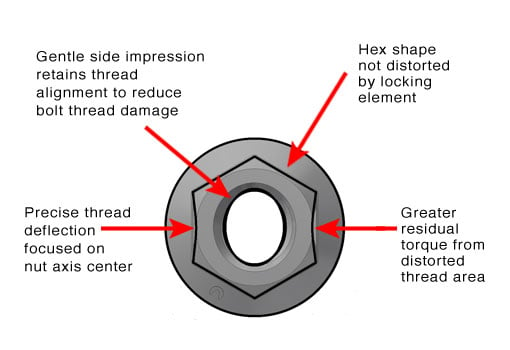Bimetallic Corrosion
While bimetallic corrosion goes by many namesvlike, galvanic corrosion, dissimilar corrosion, and electrolytic corrosion, the end result is always the same: your locknut or assembly being compromised.
What is Bimetallic Corrosion
Bimetallic corrosion is the result of two metals in a system interacting due to their different electrical potentials. Three basic conditions must exist for your assembly to experience dissimilar corrosion.
- There must be some kind of metal-to-metal electrical contact.
- The metals must have unique corrosion potentials.
- There must be a conductive liquid joining the metals.
Metal to Metal
To experience this type of corrosion, there must be metal to metal contact in some way. This could occur through direct touch or an external wire, bolt, or pipe that connect the two pieces.
Different Corrosion Potentials
Different metals have different potentials for corrosion, known as electrode potential or corrosion potential. More noble metals (cathodes) will corrode at a slower rate than less noble metals (anodes) when the pieces are in contact in a corrosive area. This is called cathodic protection.
This difference alone, however, will not determine if a material corrodes. Instead, it is simply a place to start when determining if bimetallic corrosion may be a problem.
Conductive Liquid
Many environments contain conductive liquids. Water itself is often the conductive liquid of concern and can be more or less corrosive based off of what is in the water. Drinking water, for example, islikely to be more corrosive than deionized water without impurities.
The Right Combination
The weakening of your system through bimetallic corrosion can be combatted with a combination of metals that is less likely to corrode. Choosing metals closer together on the galvanization scale may help to alleviate some of this kind of corrosion. Inserting a suitable plastic piece between the metals also can prevent this type of corrosion from occurring.
Making the Choice
With many variables to consider, choosing the right metals for your locknuts and your locknut coatings can be a daunting task. Make smart choices with the help of people who know locknuts inside and out. Our buying guide for locknut coatings can help you explore some of this information and our representatives are always happy to answer questions.
Resources:
“Dissimilar Metals in Contact.” Dissimilar Metals in Contact | American Galvanizers Association. American Galvanizers Association, n.d. Web. 15 Dec. 2016.“FAQ 1: Galvanic/Dissimilar Metal Corrosion.” FAQ 1: Galvanic/Dissimilar Metal Corrosion. ASSDA, n.d. Web. 15 Dec. 2016. https://www.assda.asn.au/technical-info/technical-faqs/galvanicdissimilar-metal-corrosion.
NationalPhysical Laboratory. Bimetallic Corrosion. Teddington: National Physical Laboratory, 2000. Bimetallic_20071105114556.pdf. NPL, 2000. Web. 15 Dec. 2016. http://www.npl.co.uk/upload/pdf/bimetallic_20071105114556.pdf.
Stainless Steel in Contact with Other Metallic Materials. Vol. 10. Brussels: Euro Inox, 2009. Euro Inox. Web. 17 Nov. 2016.
Stuart, D. Matthew. “Dissimilar Metal Corrosion.” PDH Online. PDH Center, Fairfax. 2013. S118content.pdf. Web. 15 Dec. 2016. http://www.pdhonline.com/courses/s118/s118content.pdf.







